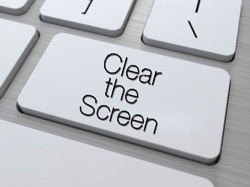Clear The Screen
 I’m playing with something I’m finding most helpful and offer it to you to see if you find it useful.
I’m playing with something I’m finding most helpful and offer it to you to see if you find it useful.
I call it “Clear the Screen.”
Imagine for a moment that there is a small screen inside your head where all your thoughts appear, whether as images or words. That thought just shows up on your screen. In most cases you don’t invite the thought in, but there it is.
Now further imagine that you have access to a button or key (like on a keyboard) that reads: “Clear the Screen.”
Once you notice the thought and decide that it’s not a productive one to continue thinking, mentally press the “Clear the Screen” key.
This much I can tell you: the thought will go away from your screen if only for a moment. The key is to press the “Clear the Screen” key each time the thought appears. After repeated clearings, the thought will come back less frequently and may completely go away.
Here’s a real life example:
I came up with this idea at the swimming pool at the fitness center I belong to. I swim a certain number of lengths of the pool as my workout. I swim three sets of 20 lengths for a total of 60. It’s just under a mile.
What I noticed was a running dialogue in my head going on as I began my first set. It went something like this: “Am I really going to swim 60 today? I was up late last night watching the debates and I may tire myself out too much by doing all 60. Maybe, just for today, I’ll cut it back to 40.” Then I answered my own thoughts with some counter-thoughts: “You’re just looking for a way to get out of your workout. Suck it up and swim the amount of laps in your routine.” And so it went.
When I noticed the thoughts, I also noticed the lane marker on the bottom of the pool was made out of small square tiles. They reminded me of keys on a keyboard. I see these tiles through my goggles about every 2 seconds when I’m face down in the water.
I set it up in my mind that every time I saw these tiles, they would represent a “Clear the Screen” command for unwanted thoughts floating across the screen of my mind. I set up an automatic trigger.
It’s something I learned from Dr. Dave Dobson. He called it a “Subjective Reversal.” I use it when I conduct stop smoking seminars. The suggestion goes like this: “Anytime you see cigarettes, whether in a rack at a convenience store or when you see someone else smoking, or you see a cigarette ad in a magazine or on a billboard, that will immediately reinforce in your mind your desire to be smoke free.”
You have taken the subject – cigarettes – and reversed your thought process about them. In the past the sight of cigarettes caused the desire to smoke. Now, with practice, the sight of cigarettes automatically reverses your thought pattern to that of being smoke free.
It’s a powerful technique. But like with all powerful techniques, it’s only powerful if you use it.
Uninvited thoughts are going to show up on your screen every day of your life. The key is to notice them and then start pressing the “Clear the Screen” key. The more often you get in the habit of doing this, over time, the process will happen automatically – resulting in less unwanted thoughts per day. After a time, I suspect you’ll report that things are going swimmingly.
All the best,
John
Be Sociable, Share!

 The Grasshopper had this to say in the wee hours of this morning: “You are your own best friend.”
The Grasshopper had this to say in the wee hours of this morning: “You are your own best friend.” I was chatting with a friend on the phone yesterday and this statement just fell out of my mouth: “If I can’t prove it, I don’t argue for it.”
I was chatting with a friend on the phone yesterday and this statement just fell out of my mouth: “If I can’t prove it, I don’t argue for it.” There is a magic bean when it comes to evolving (changing). It’s called “Interruption.”
There is a magic bean when it comes to evolving (changing). It’s called “Interruption.” The Grasshopper delivered this nip of nectar early this morning: “You will experience emotional discomfort when your conscious and unconscious mind are at odds.”
The Grasshopper delivered this nip of nectar early this morning: “You will experience emotional discomfort when your conscious and unconscious mind are at odds.” “In the space between the positions is where you’ll find the solutions.” So said The Grasshopper yesterday afternoon.
“In the space between the positions is where you’ll find the solutions.” So said The Grasshopper yesterday afternoon. The art of leaving a voicemail message is on life support and on its way to an unnecessary death. It’s not too late to save the patient.
The art of leaving a voicemail message is on life support and on its way to an unnecessary death. It’s not too late to save the patient. Here’s something each of us can say with certainty: We are the center of the universe.
Here’s something each of us can say with certainty: We are the center of the universe.